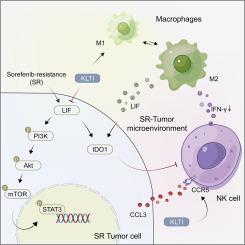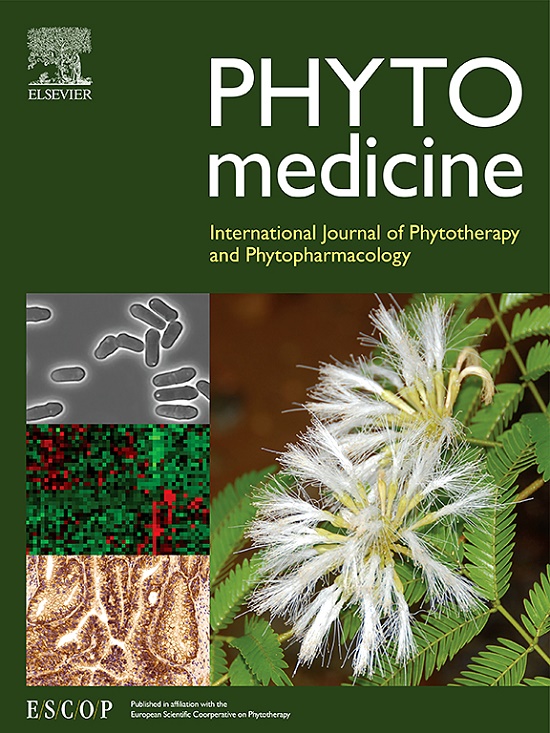肝细胞癌索拉非尼抗药性的自分泌和旁分泌 LIF 信号及康莱特注射液的作用
IF 6.7
1区 医学
Q1 CHEMISTRY, MEDICINAL
引用次数: 0
摘要
背景索拉非尼(Sorafenib,SFN)是治疗晚期肝细胞癌(HCC)的一线药物。目的本研究旨在探讨LIF调节SFN耐药微环境以及康莱特注射液(KLTI)改善HCC中SFN耐药的治疗潜力和作用机制,并指导未来HCC联合用药的研究方向。方法利用已建立的SFN耐药HCC细胞系研究HCC-肿瘤微环境(TME)中耐药与免疫抑制之间的关系。通过氯膦酸脂质体(CL)和抗NK1.1实现体内巨噬细胞和自然杀伤(NK)细胞的耗竭。体外多细胞共培养系统用于确定 KLTI 对 SFN 抗性的影响。结果肿瘤相关巨噬细胞(TAMs)和 NK 细胞介导了小鼠 HCC 的 SFN 抗性。在SFN耐药的情况下,M2样TAMs的旁分泌性白血病抑制因子(LIF)增加并有效抑制NK细胞的增殖和细胞毒性,最终导致NK细胞衰竭和HCC恶性转移。同时,SFN耐药导致肿瘤细胞自分泌-LIF增加,并进一步促进保护性自噬和获得性耐药通路PI3K/Akt/mTOR的激活。结论我们的研究结果验证了靶向LIF在SFN耐药中的治疗效果,揭示了SFN敏感性增加的潜在机制,并试图阐明这种干预如何有助于克服SFN耐药。通过调节 LIF 和巨噬细胞-NK 细胞的相互作用,KLTI 是一种很有前景的免疫调节药物,可能成为治疗 HCC 的潜在联合用药。本文章由计算机程序翻译,如有差异,请以英文原文为准。

Autocrine and paracrine LIF signals to collaborate sorafenib-resistance in hepatocellular carcinoma and effects of Kanglaite Injection
Background
Sorafenib (SFN) is the first-line medicine for advanced hepatocellular carcinoma (HCC). However, Sorafenib resistance is a main challenge of therapeutic efficacy, and the mechanisms have not been fully clarified.
Purpose
The purpose of this study was to investigate the therapeutic potential and mechanism of action of LIF in modulating the microenvironment of SFN resistance as well as Kanglaite Injection (KLTI) in ameliorating SFN resistance in HCC and to guide future research directions for drug combination for HCC.
Methods
Established SFN-resistance HCC cell line was used to study the relationship between resistance and immunosuppression in HCC-tumor microenvironment (TME). In vivo macrophage and natural killer (NK) cells depletion were achieved by clodronate liposomes (CL) and anti-NK1.1. In vitro multiple cell co-culture systems were used to determine the effects of KLTI on SFN-resistant. Likewise, flow cytometry, qRT-PCR, Western blot, and immunohistochemistry analysis were performed for further mechanistic investigation.
Results
Tumor associated-macrophages (TAMs) and NK cells mediated SFN-resistance in murine HCC. In the case of SFN resistance, the paracrine-leukemia inhibitory factor (LIF) by M2-like TAMs increased and potently suppressed NK cells proliferation and cytotoxicity, which finally inducing NK cells exhaustion and malignancy of HCC metastasis. Meanwhile, SFN resistance led to the increased autocrine-LIF of tumor cells, and further promoted the protective autophagy and activation of the acquired drug-resistant pathway PI3K/Akt/mTOR. KLTI could ameliorate the resistance of tumor immune microenvironment (TIME) and enhance the sensitivity of HCC to SFN by regulating LIF and macrophage-NK cell interaction.
Conclusions
Our findings verify the therapeutic effects of targeting LIF in SFN-resistance, uncover the potential mechanism for the increased sensitivity to SFN and sought to elucidate how this intervention might contribute to overcoming SFN resistance. KLTI is a promising immunomodulatory drug by regulating LIF and macrophage-NK cell interaction, which could be a potential combination partner for HCC treatment.
求助全文
通过发布文献求助,成功后即可免费获取论文全文。
去求助
来源期刊

Phytomedicine
医学-药学
CiteScore
10.30
自引率
5.10%
发文量
670
审稿时长
91 days
期刊介绍:
Phytomedicine is a therapy-oriented journal that publishes innovative studies on the efficacy, safety, quality, and mechanisms of action of specified plant extracts, phytopharmaceuticals, and their isolated constituents. This includes clinical, pharmacological, pharmacokinetic, and toxicological studies of herbal medicinal products, preparations, and purified compounds with defined and consistent quality, ensuring reproducible pharmacological activity. Founded in 1994, Phytomedicine aims to focus and stimulate research in this field and establish internationally accepted scientific standards for pharmacological studies, proof of clinical efficacy, and safety of phytomedicines.
 求助内容:
求助内容: 应助结果提醒方式:
应助结果提醒方式:


